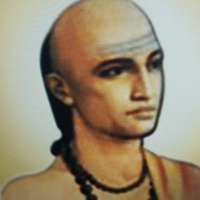Shripati
Indian astronomer-astrologer and mathematician whose astrological writings were particularly influential. Sripati was a follower of the teaching of Lalla writing on astrology, astronomy and mathematics. His father was Naga Deva Bhatta and grandfather was Keshava Deva Bhatta, although Ṡripati’s last name or title name was not mention. His mathematical work was undertaken with applications to astronomy in mind, for example a study of spheres. His work on astronomy was undertaken to provide a basis for his astrology. Sripati was the most prominent Indian mathematician of the 11th Century.
Shripati wrote various works in the first two of the three branches of astral science (jyotihshastra)—namely, mathematics (including astronomy), horoscopic astrology, and natural astrology (divination). For the first branch, he wrote Ganitatilaka (“The Ornament of Mathematics”) and the astronomical works Siddhantashekhara (“The Crest of Established Doctrines”), Dhikotidakarana (“Procedure Giving Intellectual Climax”), and Dhruvamanasa (“Permanent Mind”). Siddhantashekhara is modelled on Brahma-sphuta-siddhanta, a work by Brahmagupta (598–c. 665), and includes two chapters on mathematics; as one of the few surviving documents from this period, it sheds important light on the state of Indian algebra between Brahmagupta and Bhaskara II . Among Sripati’s works are: Dhikotidakarana written in 1039, a work of twenty verses on solar and lunar eclipses; Dhruvamanasa written in 1056, a work of 105 verses on calculating planetary longitudes, eclipses and planetary transits; Siddhantasekhara a major work on astronomy in 19 chapters; and Ganitatilaka an incomplete arithmetical treatise in 125 verses based on a work by Sridhara.The titles of Chapters 13, 14, and 15 of the Siddhantasekhara are Arithmetic, Algebra and On the Sphere. Chapter 13 consists of 55 verses on arithmetic, mensuration, and shadow reckoning. The most peculiar aspects of the Siddhanta-Sekhara are:
1. The second correction of the position of the Moon: The calculated position of the Moon may coincide with, or approximately very nearly to the observed position of the Moon.
2. Equation of the time due to the obliquity of the elliptic.
3. The correction applied for the change of declination of the Sun, in connection with the method of determining the East-West line.
4. The position of the Sun in the different quadrants of the Ecliptic Path.
5. Precession of the Equinoxes.
6. Treatise containing arithmetical and algebraic operations and discussion on the sphere, the astronomical instrument and other minor details of astronomy.
It is probable that the lost portion of the arithmetic treatise Ganitatilaka consisted essentially of verses 19-55 of this chapter. The 37 verses of Chapter 14 on algebra state various rules of algebra without proof. These are given in verbal form without algebraic symbols. In verses 3, 4 and 5 of this chapter Sripati gave the rules of signs for addition, subtraction, multiplication, division, square, square root, cube and cube root of positive and negative quantities.
For horoscopic astrology, Shripati wrote Jatakakarmapaddhati, Jyotisharatnamala , and possibly Daivajnavallabha. Jyotisharatnamala was modeled on Jyotisharatnakosha, an astrological work by the 8th-century Indian astronomer-astrologer Lalla. The two works ascribed with certainty to Shripati were highly influential on the development of astrology in India, and many commentaries were written on them.
One of the fundamental textbooks for later Indian genethlialogy, contributing an impressive elaboration to the computation of the strengths of the planets and astrological places. It was enormously popular, as the large number of manuscripts, commentaries, and imitations attests.Genethlialogy was the science of casting nativities and it was the earliest branch of astrology which claimed to be able to predict the course of a person’s life based on the positions of the planets and of the signs of the zodiac at the moment the person was born or conceived.
He had done very pioneer work in the field of Astronomy. His almost all valuable creations of astronomy and mathematics were lost some as residual are as follows:
(i) Jatakpadhatih Ṡripatipadhatirva.
(ii) Jyotisha ratnamala or Ṡripatiratnamala.
(iii) Ratnasarah.
(iv) Ṡripatinivandhah.
(v) Ṡripatisamuchchah.
(vi) Dhikotidam karanam
(vii) ‘Dhruva-manasam (a Karana, or practical manual)
(viii) Siddhanta-Sekhara.
(ix) Ganita Tilaka.
(x) Permutation and combination.

Shripati
Date of Birth: 13 Nov 2025
Birth Place: 1019 AD,Rohinikhanda, Maharashtra, India.
Proffession: astronomy and mathematics
Nationality: Indian
Death: 1066 AD


